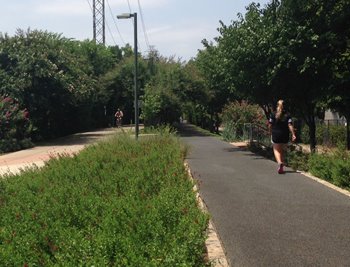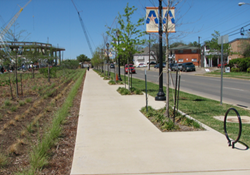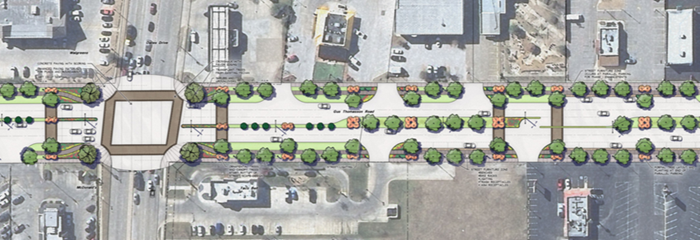NCTCOG promotes the planning and construction of green or sustainable infrastructure in the region to help reduce carbon emissions, urban heat islands, and stormwater runoff. Types of green infrastructure include LED and solar lighting, permeable pavement, “cool” pavement, bio-retention drainage areas, and shade trees.
Blue-Green-Grey Funding Program
The Blue-Green-Grey funding program focuses on breaking the silos between water infrastructure, the environment, and transportation infrastructure to help create and fund innovative spaces that combine these components. The goal of the Blue-Green-Grey program is to support innovative pilot projects that provide resources for cities and organizations to use to replicate these ideas throughout the metroplex.
NCTCOG hosted a Blue-Green-Grey Environmental Panel on April 14, 2021 to gather feedback from stakeholders about the previously implemented funding program and awarded projects. This feedback will be presented to NCTCOG boards and used to develop a fourth call for projects in the coming months.
Panel Presentation - April 14, 2021
Summary
Green Transportation Infrastructure Virtual Workshop
 The Green Transportation Infrastructure Virtual Workshop was held on August 24, 2021 from 9:30 AM to 2:30 PM through Zoom. The workshop provided a general introduction of green infrastructure practices as they relate to transportation and examples of their implementation in the Dallas-Fort Worth region. Specific project topics included permeable pavements, LED lighting, solar lighting, and low-impact stormwater drainage techniques.
The Green Transportation Infrastructure Virtual Workshop was held on August 24, 2021 from 9:30 AM to 2:30 PM through Zoom. The workshop provided a general introduction of green infrastructure practices as they relate to transportation and examples of their implementation in the Dallas-Fort Worth region. Specific project topics included permeable pavements, LED lighting, solar lighting, and low-impact stormwater drainage techniques.
Workshop Presentations
Morning Session [PDF]
Afternoon Session [PDF]
Workshop Recording
Workshop Agenda
Workshop Flyer




Green Infrastructure Resource Guide
NCTCOG completed a guidebook in 2017 to aid professionals in assessing choices for integrating green infrastructure practices into various transportation projects such as roadways, sidewalks, parking facilities, and trail projects. The guidebook provides costs and benefits of these green practices, local case studies, and key information related to long-term cost effectiveness, community improvement, and environmental impacts. The following topics are covered in the Guidebook:
- Energy-efficient LED and solar lighting
- Green stormwater infrastructure elements such as permeable pavement and bio-retention
- Green trail materials and “cool” pavements
- Urban forestry and native plants
- Local examples
- Cost estimates
Green Infrastructure Resource Guidebook (May 2017)
Green Infrastructure Brochure
Local Examples
NCTCOG has funded a number of infrastructure projects through the Sustainable Development Funding Program that utilize green infrastructure components or strategies. Below are some examples:
The Green at College Park – Arlington College Town, Arlington, Texas 
Location: Public open space adjacent to the University of Texas at Arlington Lipscomb Hall, fronting Third Street, Center Street, and Mitchell Street.
Accolades: SITES
Green Infrastructure Elements: Pedestrian walkway paved with pervious recycled glass material; bioretention drainage garden; and shade and paving materials with a Solar Reflection Index (SRI) value of 29 or greater to reduce the heat island effect.
Thomasson Square, Mesquite, Texas
Location: Gus Thomasson Road between Moon and Karla.
Green Infrastructure Elements: Bio-swales with native vegetation in the median of the roadway to help drainage and filter runoff; bio-retention area between roadway and sidewalks for additional drainage and pedestrian safety; and shade trees to reduce the heat island effect.

Additional Green Infrastructure Topics
Resources
-
Green Streets and Transportation Planning Workshop held on September 25, 2013 at NCTCOG: Flyer, Presentations
-
-
-
-
-
-